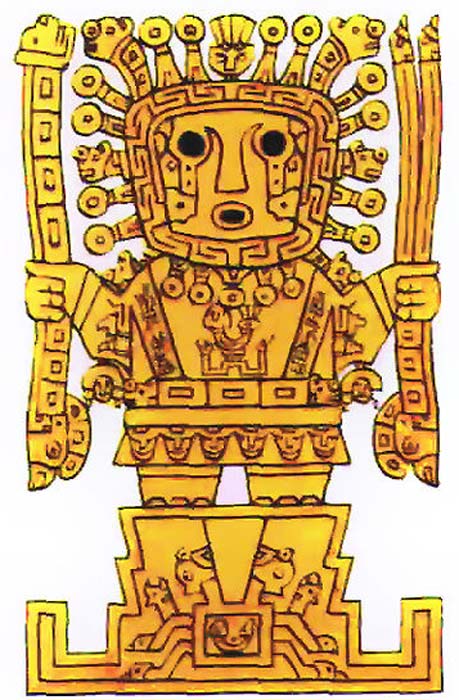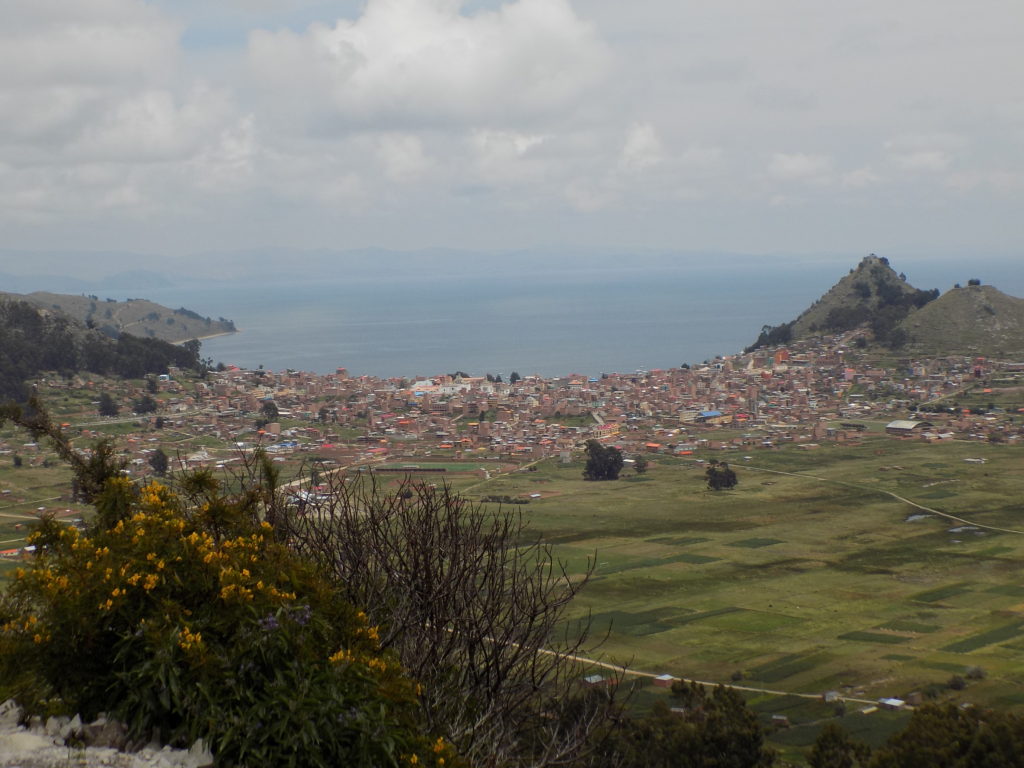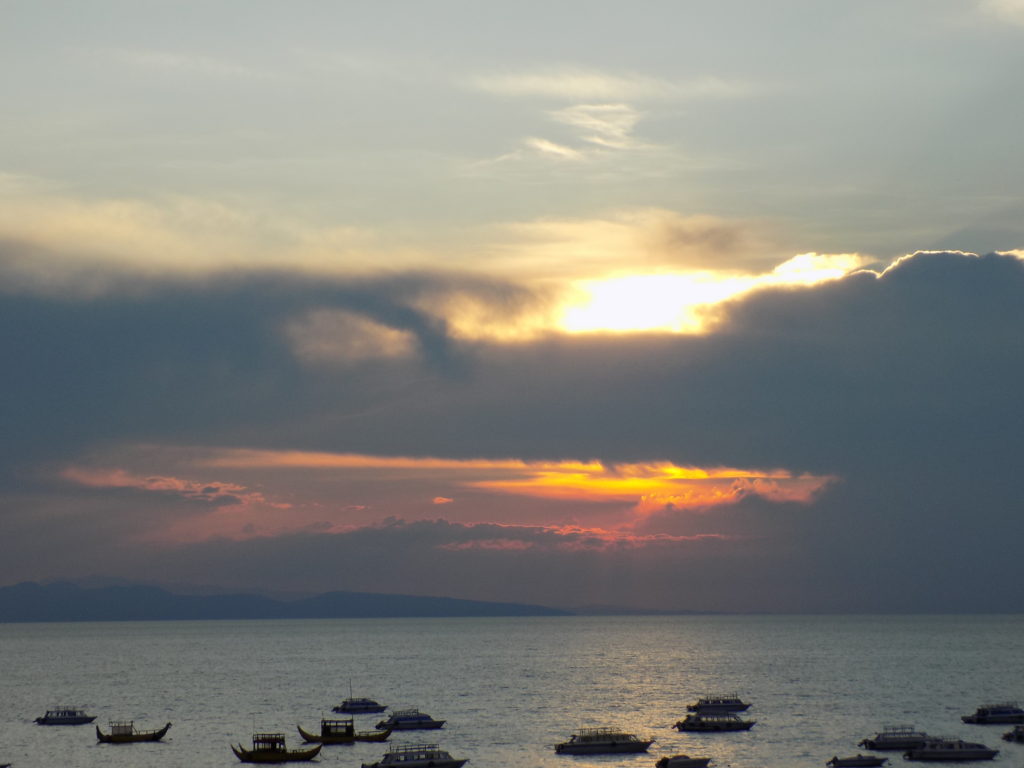Birthplace of the Inkas.
This is a representation of the Inka creator god generally called Viracocha.
[Illustration from Wikimedia – Public Domain.]
(You can find several alternate spellings and names including Wiraqocha, Wiracocha, and Apu Qun Tiqsi Wiraqutra. The last one is sometimes shortened to Qun Tiqsi which requires just a little imagination to see how it could become Kon-Tiki. The Inkas were great appropriators borrowing, and often improving, bits of cultures they conquered or sometimes peacefully incorporated. With that in mind, I’d encourage you to look again at the figure on the Puerta del Sol from Tiwanaku.)
In some ways, Viracocha is a god akin to Yahweh, the god of the Hebrews. He creates the world, populates it, doesn’t like what he sees and so destroys it only to recreate it. There are several reported stories of this process of trial and error or creation and destruction but the one that concerns us for this narrative is that of Viracocha’s son – the sun god Inti and his two daughters Mamakilla, the goddess of the moon, and Pachamama or Mother Earth.
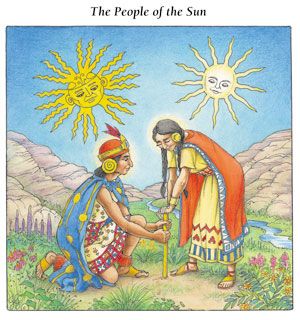
[Image of Inti and Mamakilla from Pinterest HiQu.]
After wandering the earth for some time creating other civilizations, Viracocha returned to the Andes where he discovered a culture subsumed with greed and pride. He destroyed them with a great flood with the only survivors being the children of Inti and Mamakilla. Two of these humans were Manco Qhapaq (The Spanish spelling is usually Cápac. I will generally use the Quechua but the two are equivalent.) and Mama Ocllo who rose from Lake Titikaka and were the progenitors of the Inkas.
(We have to read any of the reporting of Inkan creation stories with a mildly skeptical eye. We’ll learn later that while the Inkas may have had one or more systems of writing, none has yet been deciphered. All of the reporting of Inkan mythology stems from the 16th century reporting of Inkan oral traditions mainly from two sources – Juan de Betanzos and Bartolomé de las Casas. While Betanzos based his reporting on the stories told by his wife who had at one time been married to Inka Atahualpa, it’s likely that both men colored their reporting to better mesh with both their understanding of the world and their Catholic world view.
Even the Wikipedia page on Manco Qhapaq acknowledges as much.
In this second legend, Manco Qhapaq was a son of the sun god Inti and the moon goddess Mama Killa, and brother of Pacha Kamaq. Manco Qhapaq himself was worshipped as a fire and a Sun God. According to the Inti legend, Manco Qhapaq and his siblings were sent up to the earth by the sun god and emerged from the cave of Pacaritambo carrying a golden staff, called tapac-yauri. Instructed to create a Temple of the Sun in the spot where the staff sank into the earth, they traveled to Cusco via caves and there built a temple in honour of their father Inti.
However, given the absence of a written tradition recounting this tale before the publication of Comentarios Reales de los Incas by Garcilaso de la Vega in the year 1609, the authenticity of this legend as a legitimate Incan legend is questioned.
At the original Copacabana.
The Spanish arrived in the high Andes in 1526 and it’s reasonable to mark this as the beginning of the end of the Inka Empire. Sometime between 1526 and 1529 Francisco Pizarro had his first contact with the Inkas. Then, in 1528, Inka Huyana Qhapaq died suddenly – likely from European introduced smallpox and his death triggered a civil war. By the time Pizarro returned in 1532, the war and the spread of smallpox had weakened the empire to a point that the Spanish exploited and used to complete their conquest. The final defeat comes in 1572 with the capture and execution of Túpac Amaru the last Inka emperor.
As part of their conquest, the Spanish took control of an Inka outpost on the shore of Lake Titikaka that they might have called Kota Kahuana or Kotakawana from the local Aymara language. The first means view of the lake and the second refers to an androgynous fertility god(ess). By 1576, they had hispanicized the pronunciation and constructed a basilica on a hill overlooking the lake. This basilica came to house the image of the Virgen de Copacabana who is the patron saint of Bolivia.
While my photo from above the town
gives some hint to the shape of the beach, this panoramic view
[From Wikimedia by Christopher Crouzet.]
shows why, when a large number of Bolivians migrated to Rio de Janeiro in the middle of the 18th century, those from Copacabana saw the similarity, settled near the now famous beach, and constructed a chapel with a replica of the Virgen de Copacabana. This transformed the name of the neighborhood from Sacopenapã to Copacabana.
After checking into our hotel, we boarded a boat for the short ride to the Isla del Sol or Sun Island where we arrived at the port village of Yumani. The island is sacred to the Inkas and at least one legend says that it’s from this place that Manco Qhapaq and Mama Ocllo rose after the great flood and soared across the lake to the valley where they established the city of Cusco – the center of the Inka Empire.
Most of the island’s 80 archaeological ruins such as this one,
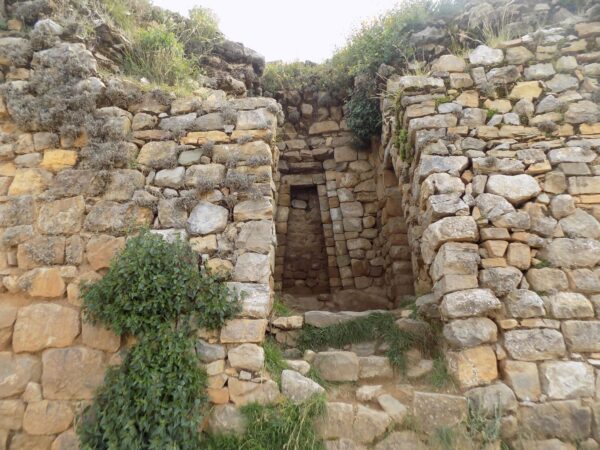
date to the late Inka period in the 15th and 16th centuries. However, excavations at Ch’uxu Qullu have found preceramic remains with a radiocarbon date of approximately 2,200 BCE indicating that the island has been inhabited or otherwise used for at least 4,000 years.
Sadly, none of us had yet acclimatized fully to the now slightly higher altitude (3,810 meters up from 3,625 in La Paz) so we didn’t stray very far from the dock at the village. We did see some nearby ruins and the Inka Staircase but none of us (perhaps with the exception of Berner) had the gumption to climb it or even walk the two kilometers to see the ruins at Pillkukayna. All of the day’s photos are here.
Wrapping it up.
We returned to Copacabana where we watched a dramatic sunset,
had a lovely dinner, celebrated Jan’s birthaversary,
and I celebrated the surprising return of a relatively insignificant item I’d left in the hotel in La Paz – my travel adapter.
When we were in Rio, the adapter I brought with me from the States didn’t work. Fortunately, I was able to buy a new one at a shop close to the hotel. It was this new one that I’d left at the Hotel Rosario in La Paz. I discovered this a few minutes before dinner when I decided to charge my laptop. Strangely, when I tried the one that didn’t work in Rio’s Copacabana, it worked in Bolivia’s Copacabana. After dinner someone on the staff at the Hotel Rosario in Copacabana alerted us that they’d sent the adapter from their sister hotel in La Paz. I doubt this would have happened had the hotels not had shared ownership. I was grateful nevertheless.
In the next post, we’ll cross the border into Peru and visit one of the most unusual places we’ll see on this trip – the Uros Floating Islands.
